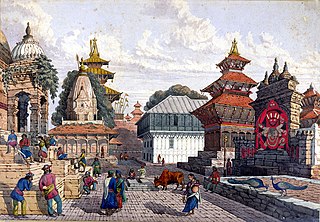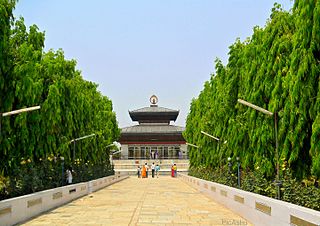Related Research Articles

The Malla dynasty was the ruling dynasty of the Kathmandu Valley in Nepal from 1201 to 1779. This dynasty was founded by Arideva Malla. Though latter Mallas were regarded as belonging to the Raghuvamsha dynasty, they were also seen as continuation and descendants of the Licchavi dynasty. Later Malla kings also traced one section of their lineage from Nanyadeva, the founder of the Karnat dynasty of Mithila. The term malla means wrestler in Sanskrit. The first use of the word malla in the Kathmandu Valley begins from 1201.
Maithils, also known as Maithili people, are an Indo-Aryan ethno-linguistic group from the Indian subcontinent, who speak the Maithili language as their native language. They inhabit the Mithila region, which comprises Northern and Eastern Bihar and Northeastern Jharkhand in India and some adjoining districts of Nepal constituting Madhesh Province in addition to some terai districts of Bagmati and Koshi Provinces. The Maithil region forms an important part of Hinduism as it is said to be the birthplace of Sita, the wife of Ram and incarnation of Lakshmi.

Mithila, also known as Tirhut, Tirabhukti and Mithilanchal is a geographical and cultural region of the Indian subcontinent bounded by the Mahananda River in the east, the Ganges in the south, the Gandaki River in the west and by the foothills of the Himalayas in the north. It comprises certain parts of Modern day Bihar and Jharkhand of India and adjoining districts of the Koshi Province, Bagmati Pradesh and Madhesh Province of Nepal. The native language in Mithila is Maithili, and its speakers are referred to as Maithils.
Mithila is a geographical and cultural region located in the Indian subcontinent. The native language is known as Maithili and its speakers are referred to as Maithils. The majority of the Mithila region falls within modern-day India, more specifically in the state of Bihar. Mithila is bounded in the north by the Himalayas, and in the south, west and east by the Ganges, Gandaki and Mahananda respectively. It extends into the southeastern Terai of Nepal. This region was also called Tirabhukti, the ancient name of Tirhut.
Jyotirishwar Thakur or Kaviśekharācārya Jyotirīśvara Ṭhākura (1260–1340) was a Maithili poet, playwright, musician and an early Maithili and Sanskrit writer, known for the Varṇa Ratnākara, his encyclopedic work in Maithili.

Maithil Brahmins are the Hindu Brahmin community originating from the Mithila region of the Indian subcontinent that comprises Tirhut, Darbhanga, Kosi, Purnia, Munger, Bhagalpur and Santhal Pargana divisions of India and some adjoining districts of Nepal. They are one of the five Pancha-Gauda Brahmin communities. Apart from the Mithila region, they also inhabit various other places in India, including Agra, Aligarh, Hathras And Mathura of Western Uttar Pradesh The main language spoken by Maithil Brahmins is Maithili.
The Gandhavariya are a Rajput clan based in northern Bihar. They are descendants of King Vikramaditya of Malwa. In past they ruled over parts of Madhepura district and Saharsa district during medieval times after the decline of the Oiniwar Dynasty.

Chinnamasta Bhagawati also called Shakhada Bhagawati and Shakhadeswori is a temple and Shakti Peethas in Eastern Nepal. It was established in 13th century by Shaktisimhadeva, the fifth ruler of the Karnata dynasty. The temple is in Chhinnamasta Rural Municipality, Saptari, 10 km from Rajbiraj near the Indian border. It is the oldest and most revered religious site in the Saptari district and draws thousands of devotees from Nepal and India during Bada Dashain and other festivals to worship the Hindu goddess Bhagawati.

Simraungadh, Simraongarh or Simroungarh is a municipality situated in Bara district of Nepal.
The Oiniwar dynasty, or Oiṇīvāra dynasty also known as the Sugauna dynasty, was a Maithil ruling dynasty of territories that form part of the Mithila region of the Indian subcontinent. They governed the area between 1325 and 1526, being preceded by the Karnat dynasty. Following the demise of the dynasty, emerged the dynasty of the Raj Darbhanga. One of the Oiniwar Dynasty's most notable rulers was Shivasimha who was known for his patronisation of the art as well as leading military campaigns against neighbouring polities.
Nanyadeva was the founder of the Karnat dynasty of Mithila. He established his capital in Simraungadh and ruled the greater Mithila region for 50 years. He is known for his generosity, courage, and patronage of scholars. He was from Karnat Kshatriya Kula and began to rule Mithila from the citadel of Simraungadh which was situated on the modern India-Nepal border, in 1097 CE. The stone inscription found at Simraongarh and Nepālavaṃśāvalī clearly states that he made an erection in a Singha Lagna of a Saturday in a Sravana, the tithi being Sukla seven and the Naksatara Svati in the year 1019 Shaka.
The Karnats of Mithila or Karnata dynasty was a dynasty established in 1097 CE by Nanyadeva. The dynasty had its main stronghold in the citadel of Simraungadh which was situated on the Bihar-Nepal border with excavations showing that parts of the fort were situated in what is now Indian territory while the rest falls within what is now Nepalese territory. The city of Darbhanga also became the second capital during the reign of Gangadeva. The kingdom controlled the areas we today know as Tirhut or Mithila in the Bihar state of India and Nepal. This region is bounded by the Mahananda River in the east, the Ganges in the south, the Gandaki River in the west and by the Himalayas in the North. Under the Karnats, Mithila enjoyed almost full sovereignty from 1097 until 1324.
Gangadeva was the second ruler of the Karnat dynasty of Mithila. He succeeded his father Nanyadeva as King in 1147 and ruled until 1187.
Caṇḍeśvara Thakkura was a Maithili-language political theorist and warrior during the 14th century. He served as minister for peace and war and chief judge in the court of Harisimhadeva who was the last King of the Karnat dynasty of Mithila. This dynasty ruled parts of Southern Nepal and modern-day north Bihar in India. His family had their origins in the village of Bisfi in modern day Madhubani district, Bihar.
Ramasimhadeva was the fourth King of the Karnat dynasty of Mithila. He came into power around 1227 CE and succeeded his father, Narasimhadeva.
Narasimhadeva was the third King of the Karnat dynasty of Mithila. Most scholars agree that he came into power around 1174 CE and succeeded his predecessor, Gangadeva.
In the 11th century, a powerful empire of Khas people emerged in western Nepal whose territory at its highest peak included much of western Nepal as well as parts of western Tibet and Uttarakhand of India. By the 14th century, the empire had splintered into loosely associated Baise rajyas, literally 22 states as they were counted. The rich culture and language of the Khas people spread throughout Nepal and as far as Indo-China in the intervening centuries; their language, later renamed the Nepali language, became the lingua franca of Nepal as well as much of North-east India. In south-eastern Nepal, Simraungarh annexed Mithila around 1100 AD, and the unified Tirhut stood as a powerful kingdom for more than 200 years, even ruling over Kathmandu for a time. After another 300 years of Muslim rule, Tirhut came under the control of the Sens of Makawanpur. In the eastern hills, a confederation of Kirat principalities ruled the area between Kathmandu and Bengal.

The Alauddin Khalji's invasion of Mithila was a military campaign conducted by Alauddin Khalji of the Delhi Sultanate against the Karnat dynasty of Mithila, led by Shaktisimharadeva, in 1297-98 C.E in present-day Northern Bihar.

Simraungadh, Simraungadh, Simraongarh or Simroungarh was a fortified city and the main capital of the Karnats of Mithila, founded by its first ruler, Nanyadeva in 1097. At the present time, the excavations now show that city is located on the India-Nepal border although there is also a municipality by the same name in Nepal. The archaeological site is currently split between Bara district in Nepal in the north and East Champaran in Bihar, India in the south.
References
- ↑ "Regmi Research Series, Volume 4". 1972. p. 10. Retrieved 7 January 2018.
- ↑ Jha, Sureshwar (2005). "Political Thinkers in Mithila". p. 192. Retrieved 7 January 2018.
- ↑ Sarkar, Benoy Kumar (1985). The Positive Background of Hindu Sociology: Introduction to Hindu Positivism. p. 514. ISBN 9788120826649 . Retrieved 7 January 2018.
- ↑ Ram Gopal Sharma (1966). "Rajanitiratnakara, A Medieval Sanskrit Text on Politics". Proceedings of the Indian History Congress. 28: 195–201. JSTOR 44140426.
- ↑ Choudhary, Radhakrishna (1970). History of Muslim rule in Tirhut, 1206-1765, A.D. Chowkhamba Sanskrit Series Office.
- ↑ Gellner, D.; Pfaff-Czarnecka, J.; Whelpton, J. (6 December 2012). Nationalism and Ethnicity in a Hindu Kingdom: The Politics and Culture of Contemporary Nepal. p. 243. ISBN 9781136649561 . Retrieved 7 January 2018.
- ↑ Jha, Makhan (8 January 1997). Anthropology of Ancient Hindu Kingdoms: A Study in Civilizational Perspective. M.D. Publications Pvt. Ltd. ISBN 9788175330344 – via Google Books.
- 1 2 3 Radhakrishna Choudhary (1961). "Harisimhadeva of Mithila". Annals of the Bhandarkar Oriental Research Institute. 42: 123–140. JSTOR 41688638.
- ↑ Sinha, C. P. N. (1970). "Decline of the "Karnatas" of "Mithila"". Proceedings of the Indian History Congress. 32: 79–84. JSTOR 44141053.
- ↑ P. Pathak (1983). "Origin of the Gandhavaria Rajputs of Mithila". The Journal of the Bihar Puravid Parisad. Vii And Viii: 406–420.
- ↑ CPN Sinha (1970). "Decline of the Karnatas of Mithila". Proceedings of the Indian History Congress. 32: 79–84. JSTOR 44141053.